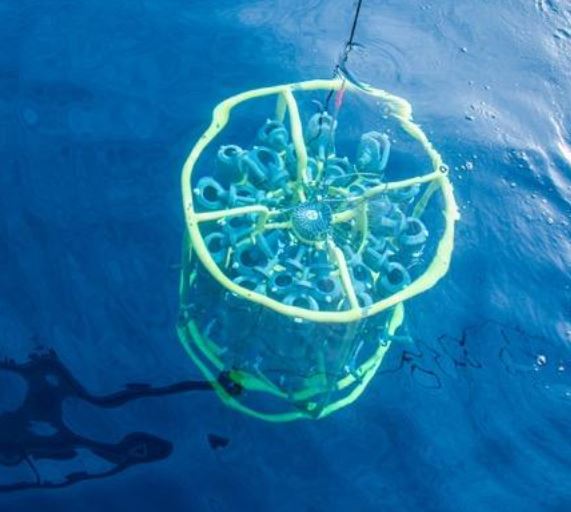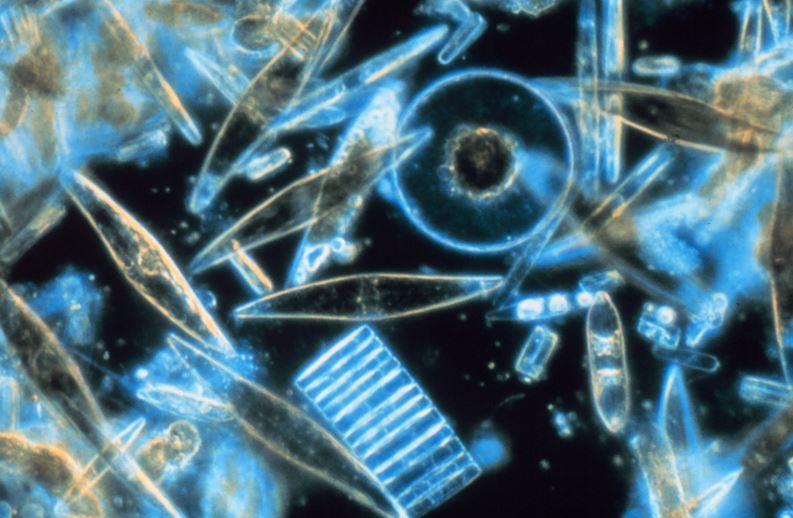A microscopic group of ocean organisms – Pelagibacterales – may solve our global warming problem, a team of scientists has suggested. These organisms, and there are a lot of them in our oceans, play an important role in stimulating cloud formation and might stabilize our planet’s atmosphere through a negative feedback loop.
The study was led by Dr. Jing Sun and Prof. Steve Giovannoni at Oregon State University, in collaboration with scientists from from the University of East Anglia and University of Exeter, among others.
Dr. Ben Temperton, who works at the University of Exeter in England, and colleagues explained in the scientific journal Nature Microbiology that Pelagibacterales, believed to be among the most abundant organisms on our planet – just a teaspoon of seawater has up to half-a-million microbial cells – play a crucial role in the stabilisation of our atmosphere.
 A rosette being submerged into the water in Bermuda to sample SAR11. (Image: eurekalert.org. Credit: Ben Temperton)
A rosette being submerged into the water in Bermuda to sample SAR11. (Image: eurekalert.org. Credit: Ben Temperton)
Dr. Temperton, a lecturer at the University’s Department of Biosciences, and scientists from the UK, USA and China, say that they have, for the first time, identified Pelagibacterales as a likely source for the production of DMS (dimethylsulfide), which we know stimulates cloud formation, and is integral to a negative feedback loop known as the CLAW hypothesis.
The CLAW hypothesis
Under the CLAW hypothesis, the temperature of our planet’s atmosphere is stabilised through a negative feedback loop where sunlight stimulates the abundance of certain phytoplankton (microscopic marine plants), which in turn produce more DMSP (dimethylsulfoniopropionate).
DMSP is broken down into DMS by other microorganisms. DMS, through a series of chemical processes, increases cloud droplets, which in turn reduces how much sunlight hits the ocean surface.
These latest findings, the authors say, reveal the importance of Pelagibacterales in this process, and pave the way for future research.
 The Pelagibacterales is an order in the Alphaproteobacteria composed of free-living bacteria that account for approximately one in three cells at the ocean’s surface. (Image: Wikipedia)
The Pelagibacterales is an order in the Alphaproteobacteria composed of free-living bacteria that account for approximately one in three cells at the ocean’s surface. (Image: Wikipedia)
Regarding Pelagibacterales’ potential for climate stability, Dr. Temperton said:
“This work shows that the Pelagibacterales are likely an important component in climate stability. If we are going to improve models of how DMS impacts climate, we need to consider this organism as a major contributor.”
The authors claim their research also revealed new data on the way in which Pelagibacterales produce DMS.
Dr. Temperton explained:
“What’s fascinating is the elegance and simplicity of DMS production in the Pelagibacterales. These organisms don’t have the genetic regulatory mechanisms found in most bacteria. Having evolved in nutrient-limited oceans, they have some of the smallest genomes of all free-living organisms, because small genomes take fewer resources to replicate.”
“The production of DMS in Pelagibacterales is like a pressure release valve. When there is too much DMSP for Pelagibacterales to handle, it flows down a metabolic pathway that generates DMS as a waste product.”
“This valve is always on, but only comes into play when DMSP concentrations exceed a threshold. Kinetic regulation like this is not uncommon in bacteria, but this is the first time we’ve seen it in play for such an important biogeochemical process.”
Dr. Jonathan Todd, from the University of East Anglia’s (UEA’s) School of Biological Sciences, said:
“These types of ocean bacteria are among the most abundant organisms on Earth – comprising up to half a million microbial cells found in every teaspoon of seawater.”
“We studied it at a molecular genetic level to discover exactly how it generates a gas called dimethylsulfide (DMS), which is known for stimulating cloud formation.”
“Our research shows how a compound called dimethylsulfoniopropionate that is made in large amounts by marine plankton is then broken down into DMS by these tiny ocean organisms called Pelagibacterales.”
“The resultant DMS gas may then have a role in regulating the climate by increasing cloud droplets that in turn reduce the amount of sunlight hitting the ocean’s surface.”
Dr. Emily Fowler, from UEA’s School of Biological Sciences, who worked on the characterisation of the Pelagibacterales DMS generating enzymes as part of her successful PhD at UEA, said:
“Excitingly, the way Pelagibacterales generates DMS is via a previously unknown enzyme, and we have found that the same enzyme is present in other hugely abundant marine bacterial species. This likely means we have been vastly underestimating the microbial contribution to the production of this important gas.”
In an Abstract in the journal, the authors wrote:
“Here, we report that Pelagibacter HTCC1062 produces the gas methanethiol, and that a second DMSP catabolic pathway, mediated by a cupin-like DMSP lyase, DddK, simultaneously shunts as much as 59% of DMSP uptake to dimethyl sulfide production.”
“We propose a model in which the allocation of DMSP between these pathways is kinetically controlled to release increasing amounts of dimethyl sulfide as the supply of DMSP exceeds cellular sulfur demands for biosynthesis.”
Citation: “The abundant marine bacterium Pelagibacter simultaneously catabolizes dimethylsulfonio propionate to the gases dimethyl sulphide and methanethiol,” Andrew W.B.Johnston, Cleo L. Davie-Martin, Jing Sun, Jonathan D.Todd, J. CameronThrash, Yanping Qian, Michael C. Qian, Ben Temperton, Jiazhen Guo, Emily K.Fowler, Mary S Lipton, Richard D. Smith, Patrick De Leenheer, Samuel H Payne, Kimberly H. Halsey, JoshuaT.Aldrich, Carrie D. Nicora and Stephen J. Giovannoni. Nature Microbiology Article number: 16065. 16 May 2016. DOI: 10.1038/nmicrobiol.2016.65.
Video – Pelagibacterales: Earth’s most successful organism
Pelagibacterales are one of the most important life-forms on Earth. They are believed to make up one in three cells at the ocean’s surface.

Comments are closed.